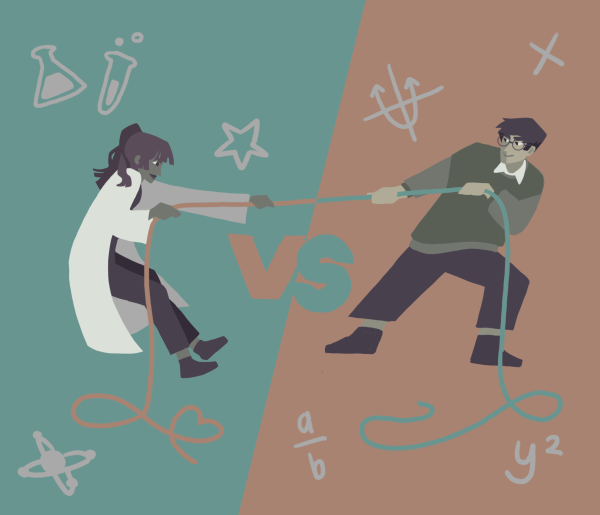SCHS students report sexual harassment and cyberbullying from sexting
This story deals with the sensitive topic of sexual harassment and cyberbullying among SCHS students. We have decided to publish it after much thoughtful deliberation and discussion. We feel that it is right to shed light on an issue as serious as this. We want to address the ever-increasing sexting between teens, and through an incident that has occurred right at home, we want to bring attention to the broader issues. We hope that through this story, we can educate teens. We ask our readers to refrain from speculating on the identities of either victims or suspects. False accusations can wreck lives. Rather, we encourage responsible discussion that can promote informed decision-making and respectful relationships. If you are or have been a victim of sexual harassment or cyberbullying, or know a victim, you can get help by reaching out to the Bill Wilson Center through the hotline 1-888-247-7717, or text GO to the Crisis Text Line of 741-741. If you have any comments or questions, you can post a comment at the end of this story, or contact us privately through [email protected]. All comments are moderated to screen out offensive or inappropriate posts.
School administration and police questioned several SCHS sophomores in late March about male students allegedly possessing and distributing revealing photographs of female students without their consent.
Citing student privacy, school administrators said they could not comment, and the Santa Clara Police Department did not return calls. However, Santa Clara Unified School District’s public information officer, Jennifer Dericco, confirmed an investigation, while declining to provide further information.
According to four students who were questioned, police and school administrators were seeking to learn how the photos were acquired, and who was involved in distributing them. One female student said police asked her several times about an Instagram account that tried to blackmail her. She said the account threatened to “expose” her and show other people her intimate photos.
“The guys who did this really make me angry because they did it like a game,” this sophomore said.
She said she was not comfortable discussing how she lost control of her photos. She said that in talking to her friends, she discovered that some of them were being blackmailed as well.
Similar incidents have occurred both locally and nationwide, raising issues of how teens can best avoid cyberbullying, and navigate a world in which it is difficult, if possible at all, to maintain control of images and information sent electronically.
In January of 2015, a student journalist at Miramonte High School in the East Bay wrote an opinion piece denouncing a Dropbox site containing hundreds of nude photos that were being shared among male students like “trading cards.” While many students were aware of the site, parents, teachers and police were not until the opinion piece was published, according to the East Bay Times.
In November of 2015, a student at Lincoln High School in San Jose was cited for posting
nude photos of underage girls – some of whom were from Lincoln – on Instagram, according to The Mercury News.
And perhaps the most well-known incident occurred at Saratoga High School in September 2012, when 15-year-old Audrie Pott was sexually assaulted after she passed out at a drunken house party, then cyberbullied by three teenage boys who shared her half-naked photos from that night with others at the school. Audrie committed suicide about a week later.
“[Having a sext distributed] is the ultimate embarrassment – it can be hugely devastating,” said Darri Stephens, senior director of Common Sense Media, an organization dedicated to helping kids harness the power of media as a positive force in their lives.
In the SCHS investigation, a sophomore male said that police’s questioning of him centered on his having received intimate photos of female students from another male student. He said other students who had received these sexts were questioned as well. Investigators took his phone and only returned it to him once they confirmed that he had deleted all the photos, he said.
“I was scared because my future could be ruined,” he said.
Due to this incident, the vibe of the sophomore class has been “destructive and undermining,” according to another male sophomore who was questioned. The tension has resulted in fights and false accusations, he added.
A female sophomore whose intimate photos were distributed said she felt like she was blamed as if she had brought the situation on herself instead of being the victim.
“People need to be more aware of how messed up this situation is,” she said.
Three students interviewed said that one of the student suspects had well over 100 revealing photos on his phone.
The Roar is withholding the names of all students quoted in this story because they are minors.
Santa Clara County’s supervising district attorney for juvenile justice, Christopher Arriola, said that sexting is becoming more and more common, even in middle schools, because kids are getting phones and Internet access at much younger ages.
Sexting statistics vary dramatically. Statistic Brain Research Institute reported in April that 40 percent of teens have sent a sext before, while a 2012 study conducted by the University of New Hampshire reports that about 16 percent of teens have created, appeared in, or received a sext.
Statistics can fluctuate greatly depending on the role of the youth involved, and whether sexting is defined as only sexually explicit images, or more broadly, according to Stephens of Common Sense Media.
Either way, Stephens believes that it is likely that the number of teens engaging in it is rising.
“Emotions and impulses don’t fully develop until 20, and that’s why teens have always been known for being risk-takers and not thinking down the road. They’re going to make mistakes,” Stephens said. “It’s just the landscape that’s changing ‒ technology is different now so the consequences are even worse.”
She added that girls feel pressured to offer up their intimate photos to appear “hot,” and thus begins the slippery slope of more girls feeling the need to sext.
She pointed teens to a Common Sense Media handbook that seeks to help them understand how and why sexting can be problematic, so that they can make informed decisions. The handbook offers three strategies for deflecting a friend or partner’s request for a sext without losing the relationship: use humor, keep it offline, and don’t fall for it if the friend or partner says they will send you their photo if you will send yours. The handbook continues that the consequences for girls of sharing naked pictures can be far worse than the consequences for boys.
Arriola warned that receiving and deleting a nude photo technically counts as child pornography and that the best thing to do in that situation is to report it.
For adults, penalties for child pornography can range from stiff fines to several years in prison, but for juveniles, consequences are more lenient ‒ focused more on rehabilitation and prevention, such as therapy. However, the penalties can include sentencing to juvenile hall, suspension from school, and withdrawal of college acceptance offers. Adult teens who are 18 or 19 could face lifetime registration as sex offenders.
In the Santa Clara High situation, police did not return calls seeking to determine whether any arrests have been made. Arriola of the District Attorney’s Office declined to comment, as juvenile court proceedings are kept confidential.
Stephens warns people to think twice before releasing anything on social media. According to the Internet Watch Foundation, 88 percent of self-generated images have been collected and put on other sites without the sender’s consent.
“The minute people press send, post, or comment, it’s out there in the world,” Stephens said. “It’s a permanent record that could come back and haunt them.”
After Audrie’s death, her parents started the Audrie Pott Foundation, a nonprofit organization dedicated to preventing cyber-bullying in schools. In October, Santa Clara High brought the foundation to campus to present an assembly to raise awareness of the issue.
Principal Greg Shelby encouraged students who are being bullied, or know of someone who is, to speak up and confide in a trusted adult at home or at school.
“People who come up and seek help are brave people,” Shelby said. “And not only will they make it better for themselves, they will make it better for others.”
Other Roar staff members contributed reporting for this story.










